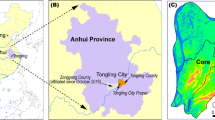Abstract
In landscape with overpopulation, intensive management for economic production, and where even small natural-vegetation patches are scarce, ecological conservation generally must be developed in the course of economic development. Thus “landscape ecological construction” has evolved in China. This approach adds spatial elements and alters landscape pattern to strengthen inter-ecosystem linkages, improve functioning of damaged ecosystems, and increase productivity and stability of the whole landscape. Five examples of managed landscapes in China are presented: dike-pond systems in a river delta; multi-pond system in a rice paddy landscape; field-grass-wood grid system on unstable sand dunes; shelterbelt network in a crop field area; and field-grass-wood mosaic system on highly erodible hilly farmland. These indicate that ecological conditions can be improved along with increased economic production. Altering landscape structure and ecological flows by introducing small landscape elements in distinct spatial patterns is considered a key to the results. This reshaping of the land has focused on changing patch size, regularity of arrangement, biological and hydrological corridors, and networks, the matrix and grain size. It suggests that such changes can increase negative feedbacks and increase stability. Finally, planning and design principles are pinpointed for the landscape ecological construction process.
Similar content being viewed by others
References
FORMAN R T T, 1995. Land Mosaics. The Ecology of Landscape and Region[M]. Cambridge: Cambridge University Press, 12–116.
FU Bo-jie et al., 1998. Impacts of land use structure on soil nutrient distribution on the Loess hill region[J]. Chinese Science Bulletin, 43(22): 2444–2448. (in Chinese)
JING Gui-he, 1991a. The landscape ecological reconstruction in some degraded land in northeastern China[J]. Acta Geographica Sinica, 46(1): 8–15. (in Chinese)
JING Gui-he, 1991b. Landscape Ecological Construction of Sand Land in the Middle-western Jilin Province[M]. Changchun: Northeast Normal University Press. (in Chinese)
LI Yu-shan, 1997. Progress of the study on soil and water conservation in the Loess Plateau[J]. Bulletin of National Natural Science Foundation of China, 11(3): 190–194. (in Chinese)
MA Shi-jun, WANG Ru-song, 1984. Compound ecosystem of society, economic and nature[J]. Acta Ecologica Sinica, 4(1): 1–9. (in Chinese)
MADS Korn M, 1996. The dike-pond concept: sustainable agriculture and nutrient recycling in China[J]. Ambio., 25(1): 6–13.
ODUM H T, 1982. System Ecology[M]. New York: John Wiley.
XIAO Du-ning, 1997. Ecological environment assessment for the “Sanbei” shelter-forest project[J]. Science & Technology Review, (8): 403–412. (in Chinese)
XIAO Du-ning, LI Xiu-zhen, 1997. Development and prospect of contemporary landscape ecology[J]. Scientia Geographica Sinica, 17(4): 356–374. (in Chinese)
XIAO Du-ning, ZHONG Lin-sheng, 1998. Ecological principles of landscape classification and assessment[J]. Chinese Journal of Applied Ecology, 9(2): 127–221 (in Chinese)
YIN Cheng-qing, 1993. A multi-pond system as a protective zone for the management of lakes in China[J]. Hydrobiologia, 251: 321–329.
YU Kong-jian 1996. Security patterns and surface model in landscape ecological planning[J]. Landscape and Urban Planning, 36: 1–17.
ZHONG Gong-pu, WANG Zeng-qi, CAI Guo-xiong, 1987. Landscape characteristics of the pond-based system in Zhujiang River delta and their exploitation[A]. In: XIAO Du-ning (ed.). Landscape Ecology: Theory, Method and Applications[C]. Beijing: China Forestry Press, 215–219. (in Chinese)
ZHOU Xin-hua, SUN Zhong-wei, 1994. On measuring and evaluating the spatial pattern of shelter belt networks in landscape [J]. Acta Ecologica Sinica, 14(1): 24–31. (in Chinese)
Author information
Authors and Affiliations
Additional information
Foundation item: Under the auspices of the main projects of the National Natural Science Foundation of China (No. 49631040 and 49731030).
Biography: Xiao Du-ning (1938 - ), male, a native of Changsha City, professor. His research insterest includes landscape ecology.
Rights and permissions
About this article
Cite this article
Xiao, Dn. Landscape ecological construction in rural China: Theory and application. Chin. Geograph.Sc. 11, 104–114 (2001). https://doi.org/10.1007/s11769-001-0029-x
Received:
Issue Date:
DOI: https://doi.org/10.1007/s11769-001-0029-x




